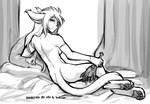
odalisque
An odalisque is a term in art used to describe a reclining figure, most often female, portrayed in a sensual or exoticized manner. The word originates from the Turkish odalık, meaning "chambermaid" or "female servant," and is historically associated with the harem culture of the Ottoman Empire. In Western art, particularly during the 18th and 19th centuries, the odalisque became a symbol of Orientalism, reflecting European fascination with and romanticized depictions of the East.
Famous artworks featuring odalisques include:
1. "Grande Odalisque" (1814) by Jean-Auguste-Dominique Ingres – A celebrated example of Neoclassical art, depicting a reclining nude with exaggerated proportions in a luxurious setting.
2. "Odalisque with Slave" (1839) by Ingres – Another striking work, featuring a sensuous woman accompanied by a musician in an exotic interior.
3. "The Odalisque" (1870) by Jules Joseph Lefebvre – A richly detailed portrayal emphasizing sensuality.
4. Henri Matisse's odalisque series (1920s-30s) – Modern interpretations using vibrant colors, decorative patterns, and flattened perspectives to evoke a playful, dreamlike quality.
These artworks are praised for their technical brilliance and aesthetic appeal but are also critiqued for their colonialist perspectives, perpetuation of stereotypes, and objectification of women, reflecting the cultural attitudes of their time.
Though the odalisque has been traditionally associated with women, depictions of reclining male figures in similar poses, while rare, do exist. For instance:
1. "Sleeping Hermaphroditus" (Ancient Roman sculpture) – A reclining figure blending masculine and feminine traits in a pose reminiscent of odalisques.
2. Modern photographic works by Pierre et Gilles – Sensual depictions of men in odalisque-like poses, challenging gender norms.
3. Sylvester Stallone’s reclining pose (1970s) – A notable example of a "male odalisque," subverting traditional gender roles in art.
The rarity of male odalisques highlights the historical imbalance in how art portrays men and women. When men are depicted in such poses, they often evoke vulnerability or irony rather than the overt eroticization commonly applied to female figures, offering insight into evolving cultural and gender dynamics in art.
Posts (view all)



